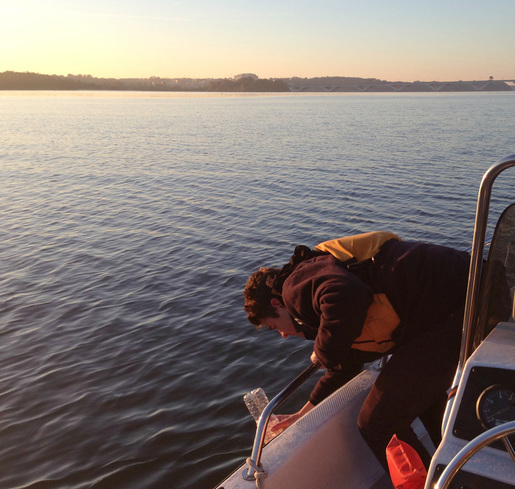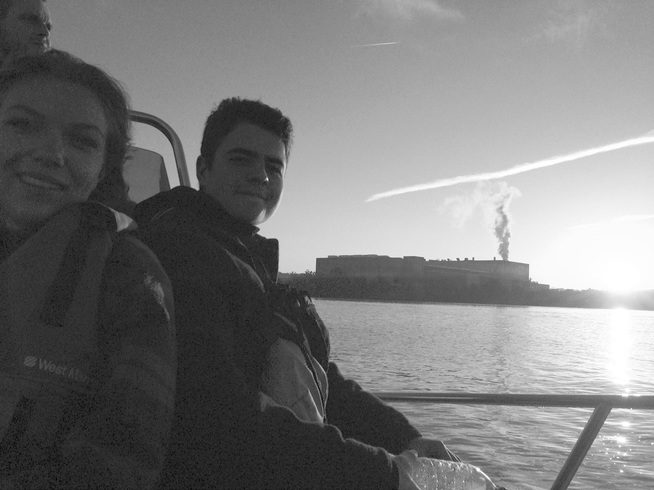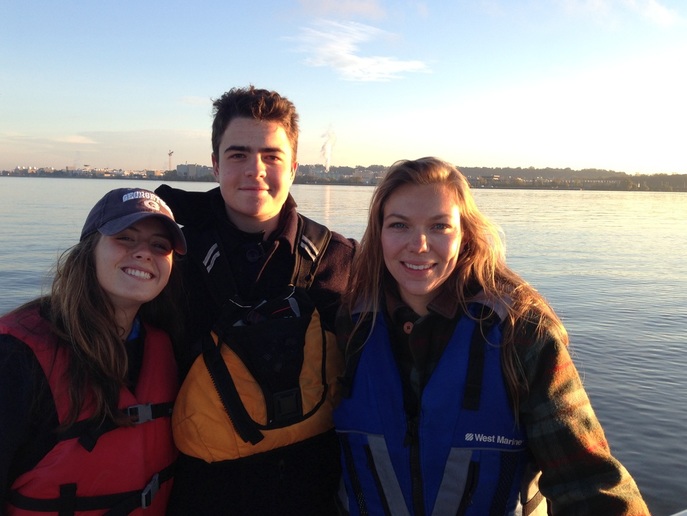By: Carter Cortazzi, Jamie Farrell, and Lola Bushnell
At 5 a.m. on a very dark and cold Halloween weekend morning, our crew of intrepid explorers assembled at Georgetown University’s front gates in Washington, D.C. Freshly awoken after very few hours of sleep and buried under about five layers of clothing (no fleece), we were itching to get out onto the Potomac River to help join the fight against microplastic pollution by collecting samples for Adventure Scientists.
We reached our friend Noah’s skiff under the cover of darkness. Even the fish seemed to be asleep. Unfortunately, the bow lights on the boat were out, so we had a brief nap on the pontoon and woke up around 7 a.m. raring to go. The sunrise was incredible, and the crystal clear, still water along with the incredible views of General’s Row, the Washington Monument, and the Capitol Building, made the whole boat trip feel like a scene from a film.
We had a few motivations for doing the water collection. Firstly, we wanted to measure the Blue Plains Treatment Plant’s efficacy at filtering out microplastics. Blue Plains, the largest advanced wastewater treatment plant in the world, is regarded as the best in America. We tested upstream and downstream from where the effluent from the plant is released, so the results will give us an idea of the ability of the plant to prevent the release of microplastics (such as the microfibers shed from fleece) into aquatic environments. If the plant does successfully capture microplastics, we will investigate further to find out how, and push for this modification to be implemented at other facilities.
Secondly, we wanted to discern the scale of the problem in our local, urban environment. As a team, we are currently prototyping and testing a product that will capture microfibers in the wash. Local evidence of the situation will motivate new audiences to address the problem. It is much harder to ignore a huge issue that is right on your backdoor. Hopefully we can educate people on the scale and nature of the problem as well as provide a product that reduces the expulsion of microplastics into our waterways.
Overall, the water testing was an unbelievable experience. Despite a few hiccups, like the bow light issue and the boat breaking down towards the end, it was fantastic fun. We were able to experience Washington, D.C. in a way we never could have imagined, but we also contributed to the scientific community in an under-researched urban environment. Hopefully the results come back without any microfibers present, but even if they do not, we look forward to conducting further research into why this is the case and continuing the fight against the microplastic scourge.
Carter Cortazzi, Jamie Farrell, and Lola Bushnell are a team from Georgetown University working to find solutions to microplastics pollution. They became involved with Adventure Scientists after developing an interest in the problem through a class they took which urged students to look for solutions to global challenges, and were motivated to act because of their passion for the environment. Carter studies Bioethics, Jamie is pursing a degree in Environmental Biology, and Lola studies Government and Environmental Studies.
Find out more about our Global Microplastics Project and other Adventure Scientists projects by visiting our website, the Landmark Notes blog and by following us on Facebook, Twitter and Instagram.



